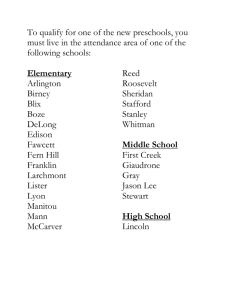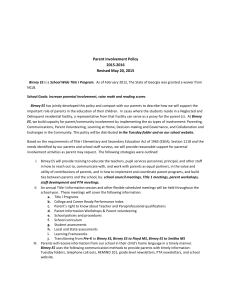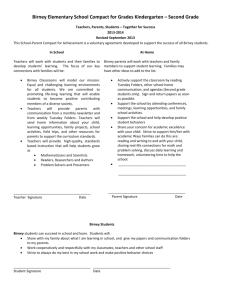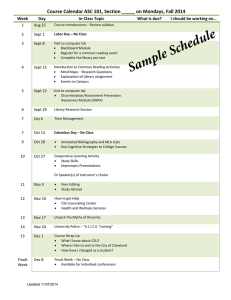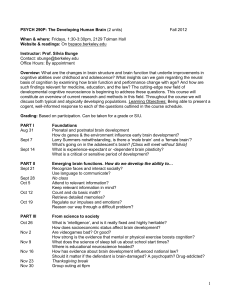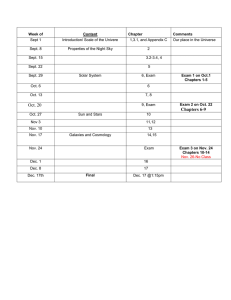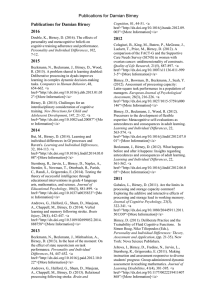Astronomy 362: Observational Astronomy University of Montana Fall 2010
advertisement
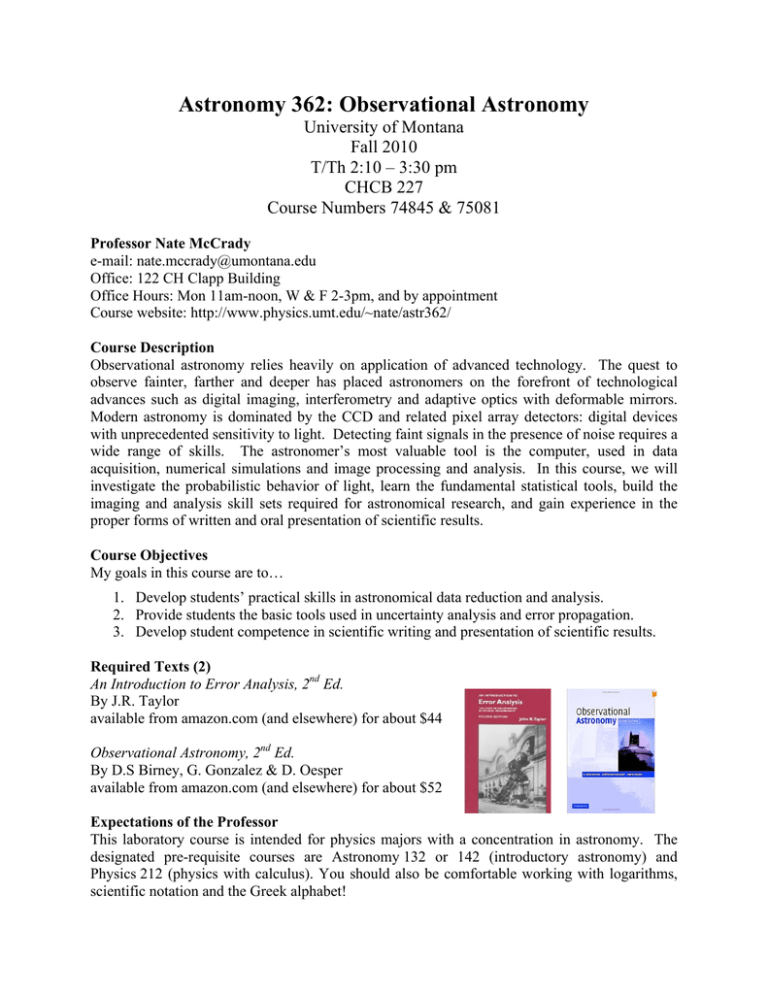
Astronomy 362: Observational Astronomy University of Montana Fall 2010 T/Th 2:10 – 3:30 pm CHCB 227 Course Numbers 74845 & 75081 Professor Nate McCrady e-mail: nate.mccrady@umontana.edu Office: 122 CH Clapp Building Office Hours: Mon 11am-noon, W & F 2-3pm, and by appointment Course website: http://www.physics.umt.edu/~nate/astr362/ Course Description Observational astronomy relies heavily on application of advanced technology. The quest to observe fainter, farther and deeper has placed astronomers on the forefront of technological advances such as digital imaging, interferometry and adaptive optics with deformable mirrors. Modern astronomy is dominated by the CCD and related pixel array detectors: digital devices with unprecedented sensitivity to light. Detecting faint signals in the presence of noise requires a wide range of skills. The astronomer’s most valuable tool is the computer, used in data acquisition, numerical simulations and image processing and analysis. In this course, we will investigate the probabilistic behavior of light, learn the fundamental statistical tools, build the imaging and analysis skill sets required for astronomical research, and gain experience in the proper forms of written and oral presentation of scientific results. Course Objectives My goals in this course are to… 1. Develop students’ practical skills in astronomical data reduction and analysis. 2. Provide students the basic tools used in uncertainty analysis and error propagation. 3. Develop student competence in scientific writing and presentation of scientific results. Required Texts (2) An Introduction to Error Analysis, 2nd Ed. By J.R. Taylor available from amazon.com (and elsewhere) for about $44 Observational Astronomy, 2nd Ed. By D.S Birney, G. Gonzalez & D. Oesper available from amazon.com (and elsewhere) for about $52 Expectations of the Professor This laboratory course is intended for physics majors with a concentration in astronomy. The designated pre-requisite courses are Astronomy 132 or 142 (introductory astronomy) and Physics 212 (physics with calculus). You should also be comfortable working with logarithms, scientific notation and the Greek alphabet! This course is scheduled to meet on Tuesday and Thursday afternoons from 2:10 – 3:30 pm. As you are no doubt aware, however, the stars are only observable at night. Three of the six labs in the course will require some nighttime observing and data acquisition. Night observing will be on dates determined by the participants (students and instructor) and the prevailing weather in Missoula. It is to your benefit to take advantage of good observing conditions when they occur, as poor weather is not considered a valid excuse in astronomy. Don’t wait to take your data! Time in the classroom is an essential part of this course, and it will be to your benefit to attend class sessions. We will devote a portion of each meeting to discussion of new material from the reading assignments. I expect students to read the material listed in this syllabus in advance of the class on a topic, and to be prepared to discuss the material in class. Each class, we will have a short quiz covering the assigned reading as motivation for the discussion. In addition, each week one student will give a brief (5-10 minute) oral presentation on the interim results of their lab group. The presentations will be an opportunity for students to share ideas and discuss what they have learned on the current lab, as well as develop presentation skills. This course is a collaborative effort – please ask questions, offer your ideas and be prepared to participate in the discussion. Written work submitted in this course must be expressed in your own words. I specifically encourage students in this course to work together, but each student must write up her or his own lab report. This step is essential to your learning – writing up the report requires you to understand the methods and conclusions of your group, whereas transcription of the work of another does not. When in doubt, please ask me what is acceptable. Pedagogical Philosophy of the Professor My primary goals in teaching an upper division lab course are to provide students with experiences in the activities of observational astronomy, and to develop practical student research skills that can be applied in undergraduate projects on campus or in summer internships such as the National Science Foundation’s REU program. During the labs, you will learn about data acquisition, instrumental calibration, uncertainty analysis, and collaborative science. In presenting your results, you will gain experience with oral presentation, science writing and graphical presentation of data. Grading Policy This course and each assignment within it will be graded on the University’s traditional letter grade system. Your grade will be based on the six lab assignments (~14% each), quizzes on the reading assignments (10% total), and a short oral presentation (6%). Note that there will be no final exam. The course will not be “curved” – I have not determined in advance how many As, Bs, etc will be assigned. Each of your lab writeups will be in the form of a scientific journal article. You will be graded on your presentation, specifically including figures, plots and captions, as well as the results of your work. Lab reports must be written in LaTeχ and must be turned in by 5pm on the due date posted on the course website. Late reports will NOT be accepted except in the case of prior permission from the professor. 2 Course Schedule & Reading Assignments Readings Tu Th Tu Th Tu Th Tu Th Tu Th Tu Th Tu Th Tu Th Tu Th Tu Th Tu Tu Th Tu Tu Th Tu Th Aug 31 Sept 2 Sept 7 Sept 9 Sept 14 Sept 16 THE POISSON NATURE OF LIGHT Computing in UNIX Basics of computer programming, IDL Errors and uncertainties, significant figures Mean, standard deviation, SDOM Distribution functions & histograms Basics of science writing, LaTeχ Unix tutorial IDL tutorial Taylor Ch 1-2 Taylor Ch 4 Taylor 5.1-5.4, Ch 11 LaTeχ tutorial Sept 21 Sept 23 Sept 28 Sept 30 DETECTING A FAINT SIGNAL Least squares fitting CCD operation CCD calibration Optical telescopes Taylor Ch 8 Birney p 159-162 Birney Ch 9 Birney p 101-108 Oct 5 Oct 7 Oct 12 Oct 14 Oct 19 Oct 21 CCD PHOTOMETRY Error propagation Celestial sphere and coordinate systems Charts and catalogs, planetarium programs Magnitude scale Stellar photometry, PSF Effects of the atmosphere Taylor Ch 3 Birney p 6-16 Birney Ch 3 Birney p93-94, then 84-90 Birney Ch 10 Birney p125-132, 137-140 Oct 26 Oct 28 Nov 2 BROADBAND CCD IMAGING Filters and colors Thermal (“blackbody”) emission Image mosaicking Nov 4 Nov 9 Nov 16 Nov 18 Nov 23 Nov 30 Dec 2 Dec 7 Dec 9 STELLAR SPECTROSCOPY Basics of spectroscopy Grating equation Wavelength calibration Spectroscopic data reduction Birney p 88-93 Birney p 93-97 Birney p 215-219 Birney p 219-223 Birney p 223-227, 229-233 SOLAR ECHELLE SPECTROSCOPY Echelle spectroscopy Spectroscopy applications Solar rotation 3 Birney p 228-229 Birney Ch 13 Birney p 266-282
